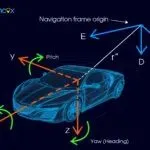The companies have shown that conducting a one-hour GNSS-free city drive is feasible while maintaining a positional accuracy within a few meters, even when driving through multi-level parking garages and highway tunnels.
 Neither GNSS nor a magnetic compass is needed. The system relies on a single MEMS Inertial Measurement Unit (IMU) paired with a Raspberry Pi 5 embedded computer that runs Nordic Inertial’s proprietary algorithm.
Neither GNSS nor a magnetic compass is needed. The system relies on a single MEMS Inertial Measurement Unit (IMU) paired with a Raspberry Pi 5 embedded computer that runs Nordic Inertial’s proprietary algorithm.
To the user, the system provides real-time position and absolute heading information in relation to the true geological north.
Murata’s newest automotive-grade MEMS inertial sensors unlock opportunities for high-volume, high-accuracy positioning and orientation control. This is enabled by their exceptional low-noise and high-stability at a competitive price point.
Nordic Inertial has invested 40 person-years into creating inertial algorithms suitable for land, air, and sea applications. M
In this collaboration, Nordic Inertial brings expertise in field-tested algorithms that ensure resilient vehicle positioning, accurate azimuth direction, and dynamic orientation control.
This accuracy and stability stem from a deep understanding of the system and its dynamics tailored for specific applications. These advanced algorithms elevate mass-produced sensors close to navigation grade
Current geopolitical instability has underscored the fragility and extensive reliance on modern GNSS positioning systems. Almost all global enterprises depend on satellite positioning for critical functions in consumer services, transportation, logistics, and safety.
Nordic Inertial and Murata believe scalable, compact, robust, and user-friendly inertial positioning has the potential to transform various business operations, just as GNSS did upon its introduction.
They point out that inertial navigation was the standard method before the advent of satellite positioning and reckon: “We are entering a new era of inertial navigation.”
